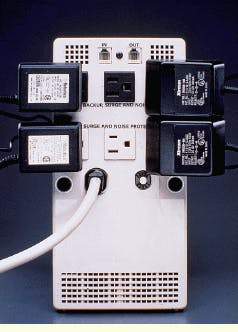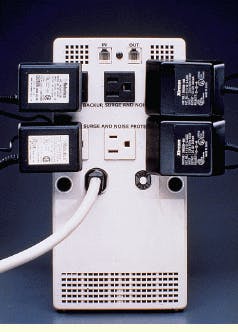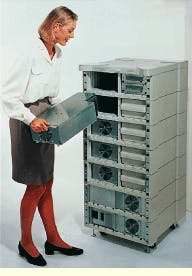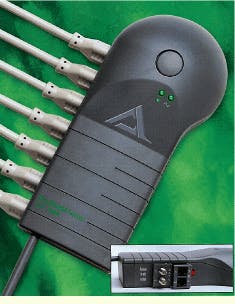upss and surge suppressors race to keep up with the networking industry.
Patrick McLaughlin
Manufacturers of passive local area network (lan) components such as cabling and connectors, as well as manufacturers of active lan components, including hubs, routers, and switches, often are thrust into research and development by the capability of personal computers to process data at ever-increasing speeds. When several of these high- performance machines are linked together in a lan configuration, the infrastructure that supports the network must be equally capable of supporting ever-increasing data-transmission speeds.
Similarly, the equipment that protects these lan devices from destructive electrical anomalies such as surges, spikes, and outages must also improve to avoid becoming the network`s weak link. Surge suppressors and uninterruptible power supplies (upss) are the devices most often deployed to combat the potentially harmful effects of power fluctuations, so the producers of these products are tasked with continually improving their offerings.
Surge suppressors and upss
The two product lines provide different forms of protection. The question of which product to use "boils down to the level of protection and the types of problems you have," says Kris Collins, media relations manager at Tripp Lite (Chicago, IL). "Surge suppressors are designed to clamp a surge that might come in through the AC [alternating current] power line."
Tripp Lite makes surge suppressors to handle that need and manufactures data-line protectors, which are designed to provide what Collins calls back-door protection. "Those data lines should always be protected," she says. "You can`t have any type of exposed connection because a surge takes the path of least resistance. Leaving yourself open anywhere on your network is never a good idea.
"Most corporations say they absolutely have to have a ups on their file servers," Collins adds, "because a ups offers uninterruptible power in addition to surge protection." The ups, then, is a more comprehensive power-protection device than a surge suppressor. In the event of a power failure, the battery inside a ups will supply power long enough to allow for a user- or software-controlled equipment shutdown--as opposed to a sudden power loss that can damage electronic equipment.
According to Viswas Purani, senior product engineer with the Data Center Solutions Div. of American Power Conversion (apc--West Kingston, RI), a ups basically has three blocks: a rectifier and charger, a battery, and an inverter. There are also three traditional types of upss, he says. In a standby ups, the inverter is typically off, or in standby mode. The standby ups performs surge suppression, whereby any extraneous surge is attenuated before it is sent to the power load. When a brownout or blackout occurs, the inverter comes into play, supplying clean power from the battery to the load.
In an online ups, the AC power is rectified and converted to direct current (DC) power, Purani says. The DC power charges the batteries and feeds the inverter; the inverter continuously feeds the load. He points out that a line-interactive ups is a hybrid between a standby and an online: "It interacts with the line when there is a brownout or an overvoltage. And it tries to kick the inverter momentarily, then again gets left to online mode."
The protection of both ups backup and surge suppression are essential, stresses Jerome Trinkl, a project manager with electrical and data-communications installation company Roman Electric Co. (Milwaukee, WI). "A ups is really only half the picture," he says. "Some people don`t put in any protection at all because they`ve never had any problems in the past. But you can learn the hard way if you do that. And if you`re going to install power protection, you may as well do it completely, by providing backup power through the ups and using surge suppressors at the electrical panels where power enters the building. Larger installations will have subpanels that need protection also."
Although using surge suppressors at outlets is helpful, two lines of defense depending on surge suppressors are safer, he adds. "Use another surge suppressor upstream," he says. "This will allow excess current to be gradually dissipated, thereby not relying on only one device, which may not be rated for a lightning strike."
Two in one
Some users have both a surge suppressor and a ups at their desktop because most upss do not contain enough outlets for all the equipment that needs protection, reports Eric Torell, business development manager with apc`s Data Center Solutions Div. "They may put a printer or fax machine on a surge suppressor to give that equipment some power protection," he says.
Both Tripp Lite and apc offer products designed to meet these types of needs. Tripp Lite`s Internet Office ups provides complete protection for a workstation for prices starting below $80, according to Collins. "The Internet Office line provides ups outlets and an additional three surge outlets," she notes. "It gives you surge protection for your printer, scanner, or anything else that might be heavy load-drawing, or that you don`t need to have backed up, but that you do need to have surge-protected." A growing trend among consumers, she says, is to buy a small ups instead of a surge suppressor. "We see business shifting from our classic surge suppressor to upss. For $50 more you can buy a small ups. Many people are doing it."
apc`s Backups Office provides multi-outlet AC surge protection, phone-line protection, network data-line protection, and battery backup for $125.
Software drives ups evolution
The most important attribute of a ups is probably its ability to supply power to electronic equipment for a period of time after a power-utility failure, thus allowing equipment users to shut down their systems gracefully. "Battery backup is probably the number one thing a customer is looking for when purchasing a ups," says Roman Electric`s Trinkl. ups manufacturers have made several significant power-supply enhancements in recent years, and most of those enhancements are software-based.
"The software has improved dramatically over the past four or five years, and particularly in the last two years," says Jerry Zechmeister, president of Automated Power Technologies (Lake Forest, CA). "Almost all upss are now shipped with bundled software, probably because most upss interface with computers. The software allows popular systems, such as Windows 95 and Novell, to shut down gracefully without someone having to be at the computer every instant. Really, there`s no difference between the battery running out on a ups and the utility failure in the first place, making automatic shutdown very important."
Collins says Tripp Lite`s Power Alert Plus software package "gives the user good, immediate information. It pools all the data from every ups on the network. This allows an IS [information systems] manager in New York to tell, from a single workstation, if a ups on the network in Miami has kicked on, has a bad battery, or experienced other power-related events." She says this type of intelligence allows IS managers to be more proactive in supporting and controlling their networks.
Tripp Lite has also introduced a universal driver, which can manage the software of other ups brands. Collins says the driver is particularly helpful to companies involved in mergers because it allows both entities to keep their existing upss. "With the universal driver, all your equipment doesn`t have to come from the same manufacturer," she explains. "You can keep your legacy upss intact, and Tripp Lite will control those upss with PowerAlert Plus software."
She adds that another ups-software concern is year-2000 compliance. "That`s a big issue in this industry," she says. "But again, with our universal driver, if you have a ups solution that is not compliant, we can take over the running of that non-compliant ups solution and you will become compliant by adding the Tripp Lite solution."
Best Power (Necedah, WI) developed and incorporated into its software package an adaptive algorithm to accurately predict battery run time. Barry Papermaster, Best Power`s vice president of strategic marketing, comments, "The least reliable component in any ups is the battery. Best Power has developed technology to improve battery life. The Best Power internal software analyzes historical and real-time data to dynamically calculate end-of-runtime. This provides the end-user with the maximum protection. In addition, the software performs smart battery charging to maximize battery life. Batteries age based on number and depth of discharge, charging, and temperature. The software analyzes all those factors to more accurately charge the batteries."
Longer run times
Other recent ups enhancements also allow the devices to supply power for longer periods of time during a utility failure. "There is a big market now for extended run-time ups models," notes Automated Power Technologies` Zechmeister. "And that market is growing rapidly. For telephone systems and other systems that don`t have an interface for shutdown, extended run time becomes extremely critical. In the past, the solution many came up with was to oversize the ups. But now, extended run-time models are available. They are really the right-size ups but include an infinite number of batteries to get the runtime needed. Particularly for telephone applications, we sell two-hour-backup upss regularly."
These extended-runtime models serve two purposes, he says: "First, the power can come back on before the system shuts down. And second, the user can continue to have phone service throughout that outage. That is critical in a sales situation and even more so in the case of a 9-1-1 or some other emergency service."
Best Power has also taken technological steps toward powering devices without using the battery. "In the past, energy typically passed through a ups to supply the critical device," explains Papermaster. "In an over- or under-voltage situation, a device would draw energy from the battery. Best Power introduced buck-and-boost features in the ferrups line of upss. If the voltage is too low, a ups can elevate it [boost] without going to the battery; or if the voltage is too high, the ups can reduce it [buck] and still let the current pass through the ups without going to the battery. This feature significantly extends battery runtime during a power loss."
Hot swappability
Hot swappability has also transformed the ups market, asserts Papermaster. "Previously," he says, "when a battery needed to be replaced, it required the ups to be deactivated [first]. This exposed the devices during that period. Hot-swappable upss allow real-time, online replacement of the battery. You can literally unplug the old battery and plug in a replacement."
He further explains how the ups continues to protect equipment while the battery is replaced. "Energy passes through the ups at all times and typically trickle-charges the battery. A Best Power hot-swappable ups allows the user to open the bottom, disconnect the old battery, and reconnect the new battery."
apc says it has taken hot-swappability--and in fact, all ups technology--to a new level with its Symmetra product, which began shipping in September 1997. apc`s Torell says this "new breed" of ups, which apc calls the Power Array, answers the customer demand that the company has seen develop over the past few years.
"We found a lot of people who wanted to buy one ups," Torell explains, "and instead of buying more upss and scaling them out, they liked the idea of being able to grow in power requirements within one ups frame. So we designed a unit called the Symmetra, with which you can scale both power needs and run-time needs in one box. There`s an additional box for batteries, but primarily you`re able to grow your system to fit the needs of your applications as they change over time."
Purani states that with Symmetra, apc modularized the ups into three independent modules: batteries, power modules, and intelligence electronics. "All three modules are redundant in this application," he says. "Users want redundancy because data centers are so mission-critical, and the computer industry has come up with redundant technology in all spheres. For example, computers have clustering of microprocessing and microcomputing units. Disk drives are also redundant. In the data center, there was no single point of failure except for the ups. And apc`s design around it was to develop a unit that had no single point of failure."
He adds that Symmetra provides the user with voltage control and frequency control. "If you`re on bypass, you have no control over voltage and frequency that the main switch is feeding to the load. With this extra module, you have control so that a clean, regulated line is being fed to the load at all times."
Users who purchase Symmetra, which is available in MasterFrame and MiniFrame models, can buy additional battery and power modules as the data center grows.
Surge suppressors also adapt
In a similar vein, surge-suppressor manufacturing has tracked the computer industry and is evolving to meet the technology`s ever-changing power-protection needs.
Convergence of technology is injecting life into the surge-suppression market, states Tony Bird, president of Atlantic Scientific Corp. (West Melbourne, FL). "A lot of surge-suppressor manufacturers provide quality devices with fairly similar performance at fairly similar prices," he says. "So I believe the differentiation among surge suppressors will come on the applications side of things.
"There are huge changes happening in terms of convergence of technology. TVs now act as computers, computers act as telephone answering machines, and so on. Technology is converging. What that means in terms of surge suppression is that a given piece of electronic equipment now has more ways of communicating with the outside world. And every conductive line that comes into a piece of electronic equipment is a route for surges to gain access to that equipment.
"The old surge suppressors won`t fill the wide range of connectivity that the next generation of equipment will require. Think about the possible combinations of protection you may need: telephone and AC power, cable TV and AC power, and a lan and AC power. Then there are others combinations, such as a lan, telephone, and AC power. The mind starts to boggle, and the old preconfigured surge-suppression packages just won`t work."
Toward the end of last year, Atlantic Scientific released a platform-concept device that Bird says "mirrors the PC approach in a surge suppressor. Basically, we copied the technology that we`re protecting. To protect a modem, lan, or cable TV, you slide in the appropriate module." To accommodate these modules, the unit comes standard with three bays.
Bird says that adaptation of this sort will be necessary for power-protection equipment manufacturers to survive in a continuously changing technological environment. He adds that users can look for communications-line protectors to be upgraded as other network components advance. "We as manufacturers will simply have to keep up with the technologies," he concludes.
Other ups differentiators
Software features and modularity may be the flashiest developments in ups technology, but equipment makers also search for other ways to differentiate themselves. For example, Automated Power Technologies has built different configurations into its upss. "Instead of having them sit on the floor, we have a wall-mount ups that mounts below a telephone system and vertical towers that mount beside tower computer configurations," Zechmeister notes. "Also, our front-panel display pops out, and you can move it around the room on a telephone cord. This allows you to mount the ups in the telecommunications closet, then run the front panel out to your desk."
Both apc and Best Power recognize that education and consulting services can differentiate one ups provider from another.
"We work closely with an extension service at the University of Wisconsin," says Best Power`s Papermaster. "We also provide classes and services for our distributors to learn about power and how it works, so they can be more valuable to their customers. If you understand power and how it works, you`re more credible. And buying the equipment is like buying insurance on your power. You want to make sure the insurance company is going to be there behind you."
apc has established support groups with power-quality analysts and systems analysts that perform such services as helping users size their loads and assisting with purchasing decisions. apc also offers a series of nationwide seminars to provide sales and technical training to resellers, as well as a power-quality auditing service called the Power Audit--on a contractual basis.
Tripp Lite`s Internet Office 420 LP offers the protection of a UPS and additional surge-suppression outlets in a single unit.
The modularity of American Power Conversion`s Symmetra ups allows users to add battery, power, and control-electronics modules as their systems` needs grow.
The ProShield surge suppressor from Atlantic Scientific Corp. includes Bays where users can place modules that protect local area network, cable-TV, and telephone lines.
Power Protection: Whose business is it anyway?
Although the concept of power protection revolves around high-voltage wiring, professionals in the low-voltage communications cabling industry are becoming increasingly involved. Some end-users look to their data-cabling installers to offer direction, and sometimes products, related to power protection. So, whose business is it, really?
Manufacturers of power-protection equipment have varying opinions. Jerry Zechmeister, president of Automated Power Technologies (Lake Forest, CA), says power protection Ois becoming everybody?s issue. There?s virtually no one we talk to who doesn?t have some sort of a requirement for power protection, whether it?s a single PC or a corporate person who?s responsible for an entire MIS department.O
When asked if he finds that installers and maintainers of communications cabling are primarily responsible for power protection, he responds, OIn some cases they are, and in others they aren?t. But should they take more responsibility? Absolutely. If cabling is installed without a ups [uninterruptible power supply], there will be a lot of finger-pointing if there?s a problem.O
He says that working with power protection is also an opportunity for systems integrators to increase their business and ensure that their customers are satisfied in the long run. OI think a lot of cablers would like to be able to install a ups, to make extra money and ensure that the customer has all the power protection and surge suppression necessary.O But, he says, not every cabling installer is interested.
Barry Papermaster, vice president of strategic marketing at Best Power (Necedah, WI), says that the modular furniture often found in today?s office environment and often handled by cabling installers can be a significant source of power problems. He explains that an electrical system is designed by an engineer, who must take into consideration the power that goes to each outlet.
OAn engineer calculates the distance from the plug to the feeder, the gauge of wire to run, quantity of energy it must carry, and total number of outlets,O he says. OThe engineer then designs a system to ensure the appropriate power at each plug.O
In the cubicle environment, equipment is constantly moved around, leaving some cubicles full and others empty. That may cause unbalanced power, as well as long cable lengths with large power demands on specific cables. By the time the power gets to the farthest cubicle, the voltage may be so low that it will not support a computer.
In the communications industry, power-quality assurance is less associated with cabling and more with bridges, routers, and hubs, Papermaster adds.
He says that his company commissioned a testing lab to conduct a power-quality study that included 7000 sites in the United States. OWe found that 90% of the problems are caused on-site, and the average site gets 289 power disturbances per year,O he reports. OSo power quality is a huge concern. And it?s important to know that even if the building next door to you doesn?t have a problem, your elevator or your air-conditioning system may be causing problems for you.O
Tony Bird, president of Atlantic Scientific Corp. (West Melbourne, FL), recently gave a presentation on surge suppression at bicsi?s (Tampa, FL) 1998 Winter Conference. He says that based on the reaction he got after his presentation, he detects a lot of interest in the subject among professionals in the cabling field. OAttendees were lined up 10 deep to talk about surge suppression,O he says.
Kris Collins, media relations manager at Tripp Lite (Chicago, IL), says that knowledge of power protection can enhance a cabling installer?s relationship with long-term clients. OSome companies rely on the relationships with their data-line professionals,O she says. OIf these data-line people are at the forefront and have all these other products to offer, they?re going to get the business regardless of who actually informs the end-user that power protection is needed. And cabling professionals understand the needs and implications of power protection, including the damaging effects of power fluctuations.O



